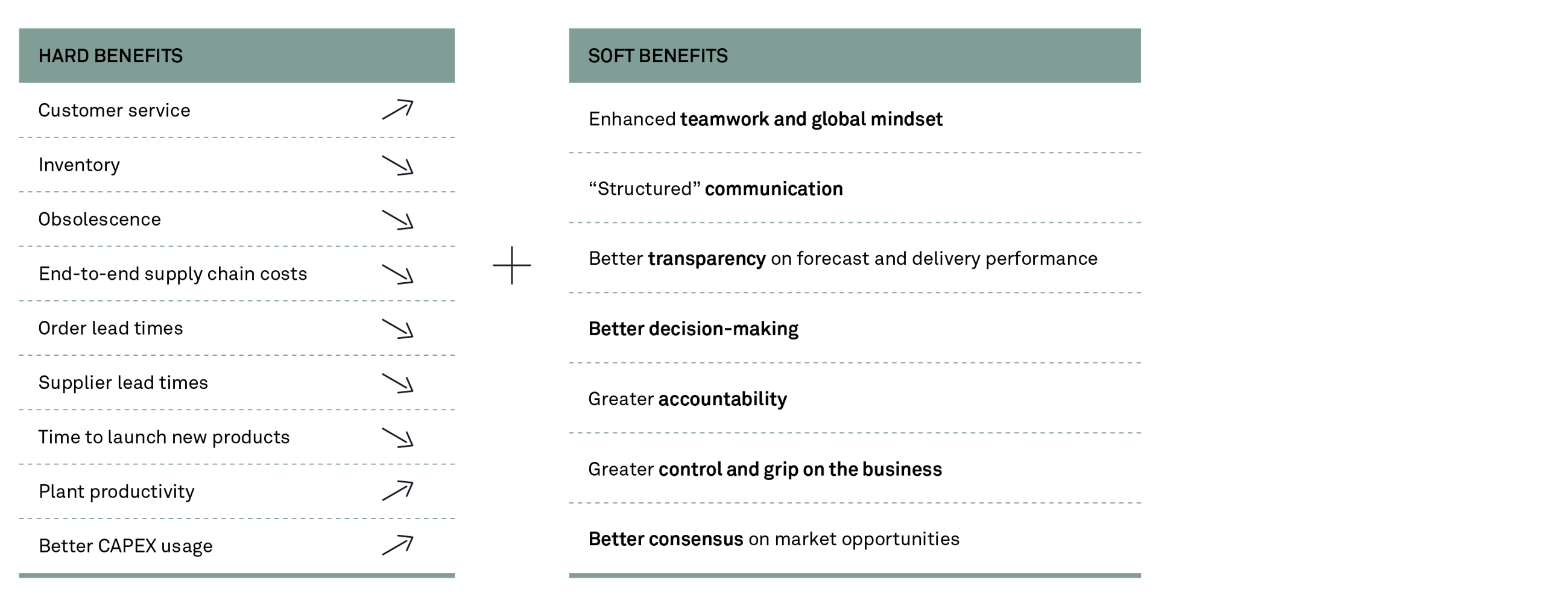Arla and Implement Consulting Group
3 April 2018
When EU removed their milk quota system in 2015, Arla’s supply chain came under significant pressure. Working closely with Arla, Implement designed the ONE Planning & Allocation programme to give the organisation a global overview of demand and supply. Learn how processes, people and IT came together in a uniform system.
After more than 30 years of existence, the EU milk quota system was scrapped in early 2015, resulting in a substantial increase in the amount of milk produced by European farmers. This again has had several consequences, the most obvious being a significant drop in the milk prices, putting many European milk farmers under pressure.
As one of the world’s largest dairy companies, Arla Foods has been directly influenced by this development. Not least because the company, as a co-operative owned by the milk producing farmers, is obliged to take in all the milk they produce.
Add to this the limited durability of milk combined with an extremely fluctuating market and increased pressure from still larger and more global customers, and you have a challenging situation. But also a situation with significant benefits associated with creating a global overview of demand and supply in order to balance the further processing of milk in the best possible way. For a company like Arla, having experienced a tremendous growth up through the 00’s and early 10’s, this task is easier said than done. New markets, new suppliers and production facilities all across the world had stretched the old country and market-based operating model to its limits.
The growth, primarily through mergers with other dairies, had given Arla the milk and the markets they had set out for, but also a scattered IT landscape and multiple ways of doing things across the global company.
ONE Arla through a global overview of demand and capacity
Thomas Carstensen, Senior Vice President Milk and Trading says:
“In Arla’s 2017 strategy plan, our top management provided us with a very clear mandate, which was to develop and implement world-class trading and milk allocation within a period of four years”. That was in late 2013, and today, not even three years later, Thomas Carstensen and his team can conclude that the results so far are promising to an extent where Arla’s CEO, Peder Tuborgh, refers to the new Sales & Operations Planning (S&OP) process as “the pulse of Arla”.
From a supply-driven to a demand-driven process
When Arla introduced S&OP, it was important to change the entire mindset of the organisation from one where the markets, roughly said, fended for themselves, and the core markets’ supply chains were focused on supplying the market that “owned” them. To handle the increased milk inflow, which was expected after the milk quota abolishment, and to serve the customers who were growing more global, the top management foresaw a need for the markets and supply chains to work together as one in a more uniform and structured way.
Hence, they ordered a global monthly tactical decision process named Arla Sales & Operations Planning and an underlying standard SAP APO IT landscape that could decommission the many legacy systems to be developed and rolled out. The program ONE Planning & Allocation was set in motion.
Jakob Lignell, Director, Global S&OP and head of the programme ONE Planning & Allocation says:
"With a background in sales, my primary role has been to negotiate the change process, getting to one harmonised S&OP business process and organising the programme. Doing it in a way that supported the various functions and also finding compromises on standardised SAP APO templates. It has truly been a team effort with Arla staff wanting to succeed as one, and external consultants understanding the need to show value early on."
In order to make the transition, it was necessary to introduce a process that could produce a reliable demand forecast on the one hand and a viable plan for meeting that demand on the other on a global scale. The process defined by Arla starts with Sales delivering quality and commitment for the volume forecasting at the demand review meetings (DRM) headed by head of sales in all markets. The new global demand planning template plays a key role in getting valid global transparency on demand.
The DRM is followed by gap-closing activities at the business planning meetings in the markets’ leadership teams and in the two overlaying commercial zones that have been created in the new “Good growth 2020” strategy. An organisational change that also gave Arla a supply chain divided into two main functional areas. Providing a clear line of sight from the 2017 strategy programme mandate and, hence, supporting the end goal of one S&OP process, one standard IT landscape and one set of numbers.
All plants then look at the demands at local plant review meetings (PRM) and give input to the two supply review meetings (SRM). This is done in a standard format guided by the new SAP APO master production planning template. The three most important global overviews across all sites provided by the master production plan.
The process ends with a large meeting with all heads of sales, supply chain, planning, product management and category supported by finance, being briefed on hard numbers and deciding on corrective actions to take on tactical issues for the coming 1-15 months. Also, setting the guiding operational principles for Arla.
Thomas Carstensen, Senior vice president Milk and Trading explains:
"The global executive S&OP meeting is a bit like the tale of the bumblebee that should not be able to fly. Too many issues, too many people and too little time is often what we hear from new people being introduced to the concept. But the fact-based format supported by our IT standardisation efforts and the structured process leading up to the meeting underlined with sheer decision power and teamwork across the company makes it work to an outstanding degree."
“Overall, and this goes for both the business process as well as for the programme as such, we have implemented a mindset saying that silence is acceptance. We provide the necessary information on the right level of detail and to a forum for people to voice their opinion. That said, we are always tender-hearted on the people, but tough-minded on the issue”, says Jakob Lignell.
Designing an S&OP process and IT-enabling systems is all about people and governance
Arla set out to get the basic business process aligned and started up before embarking on the IT part of the programme. This made it easier to align on IT requirements, but it also enabled Arla to harvest many IT and business benefits as early as possible in the programme.
When asked, Jakob Lignell points out the actual management of the programme as one of the deciding factors for the success: “Right from the beginning, it was important for us to create results early in the projects and on an ongoing basis. We were inspired by an initiative from The Danish Industry Foundation called “Project Half Double” where the aim is to create results in half the time with double the impact”, he says.
This approach had several consequences for the way that the project was managed. One was the decision not to wait for 100% solutions, but to be pragmatic and learn from practical experience in smaller and more flexible loops. Another was to do away with the well-established routine of rolling out solutions one market at a time and change to a roll-out by product group. By doing so, the project team is able to introduce global overviews on for example capacity early in the project as opposed to waiting until all markets and their product groups are aligned.
“A crucial point was also to have clear line-of-sight governance that insured a high level of involvement of stakeholders in sequenced forums through the different levels in the organisation, anchored with an executive management steering committee. All forums having clear role descriptions and mandates to agree on a common way of working or standard APO template design features and accepting the escalation points if consensus could not be reached at a certain level. This, combined with a very active business ownership approach and a dynamic IT organisation, has insured that the programme has stayed on time and budget throughout its course” says Senior Vice President Torben Fabrin, Arla IT.
Measuring impact
The overall impact case was built around our S&OP KPIs that were defined in the early days of the programme. Forecast accuracy being the key measure to track improvement. In this simple way, we have been able to track a significant improvement of the overall performance, delivering well above expectation already 18 months before the programme is set to end. A big part of this improvement is derived from the business process and the training in the SAP APO demand planning template, but “the biggest surprise for me was that we only saw a very minor drop in forecast accuracy after first-user go-live of our new demand template and a learning curve taking us above par already after one month,” says Jakob Lignell.
More tangible benefits for the business, and what has proven to be the true value for Arla, is the global transparency creating alignment and decisions that are cascaded throughout the organisation in an increasingly seamless way. Making our top management eager to take part in the different steps in the S&OP process.
Issues like clear market prioritisation when in lack of products or raw material is a constant theme. An example could be a temporal lack of organic milk that has become very sought after by the consumers: “A topic like this is close to heart for all markets and will give a lively debate, and it is vital that we can trust the numbers supplied at the meetings”, says Jakob Lignell.
Other examples are the clear guiding principles that are formed via casebased decisions that are actively lifted to principal guidelines helping steer the company with less friction. Demand shaping built on optimal overall profitability is also a recurring event at the meetings as well as movement of production between plants and gapclosing activities built on top of the realistic demand plans supplied by the SAP APO demand planning template.
The examples above are just a few among several others that underline the impact created by the One Planning and Allocation programme.
Overall, the process also supports hard benefits such as better customer service, reduced inventory and lead times, higher productivity and better CAPEX usage. The benefits acquired also include more intangible ones like better decision-making, enhanced teamwork, a more global mindset, better transparency, structured communication in a common language and much better consensus on market decisions.
S&OP creates a clear meeting structure to enable transparency on demand and supply – and an escalation forum where potential issues or demand-shaping opportunities can be raised to top management to make well-informed decisions that maximise value across Arla as a global entity.
Learnings
For Jakob Lignell and his team, and not least for Arla, the One Planning and Allocation programme has been a success. This is, of course, basically a direct result of a tremendous effort, change readiness and willingness to contribute of all involved parties in Arla. But if we take a deep dive into the underlying factors, it is possible to pinpoint the vital few success factors that other companies and project managers facing a similar challenge may benefit from:
- Focus on impact early in the project.
- Create an environment of trust between IT and the business.
- Be ambitious regarding the vision and the end goal of the project.
- Be pragmatic and flexible in the process – rather go for the 20% that are used than waiting for the entire solution to be finished.
- Don’t be afraid to present solutions that are not 100% perfect and learn as you go along.
- Remember that while plans and systems are important, it is all about people in the end. So be tenderhearted on the people and toughminded on the issue.







